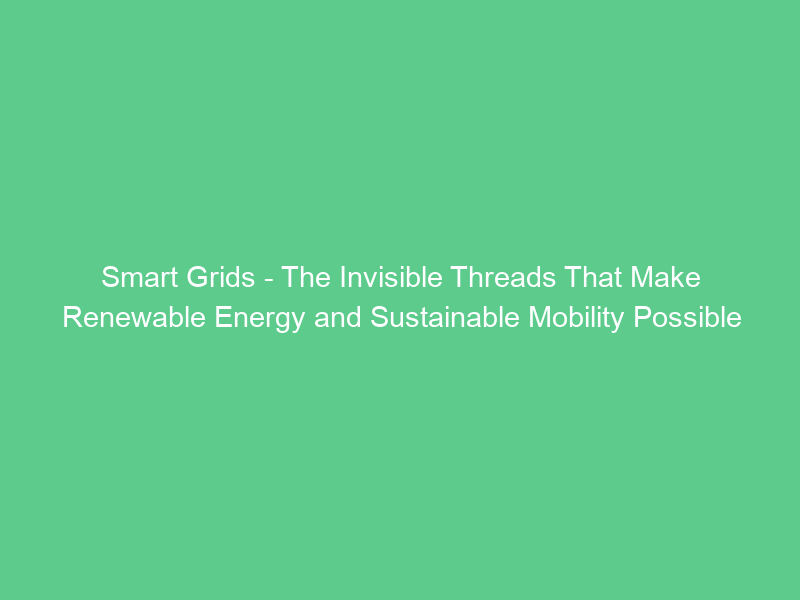Smart grids are the backbone of renewable energy and sustainable mobility, making renewable power accessible to homes, businesses, EV charging stations and utilities alike. Their presence enables green electricity to flow to all corners of society while giving utilities new tools to manage energy distribution more efficiently.
Smart grids adapt quickly and smoothly to sudden surges in demand, relieving strain on the system and avoiding outages. In addition, smart grids send price signals directly to appliances and vehicles in order to incentivize reduced consumption during peak hours.
Enhanced Reliability and Resilience
Smart grids use advanced monitoring systems to quickly detect power supply problems and isolate them, thus decreasing frequency and duration of disruptions and increasing reliability for power distribution networks.
Renewables also allow for the integration of energy storage systems, which optimize their usage more effectively by storing excess power produced from renewable sources and then releasing it when needed. This ensures a more reliable and stable electricity network during times of high demand or natural disaster.
Smart meters and communication networks can also enable Demand-Side Management programs, inducing consumers to reduce energy usage during peak periods in order to save utilities money and avoid expensive infrastructure upgrades. Smart grid capabilities can even go beyond utility meters by connecting low priority home devices like water heaters with renewables in order to make local clean energy production simpler for individuals – thanks to increased availability and affordability of energy storage technologies.
Enhanced Efficiency
Smart grids can quickly identify issues such as power surges or outages with advanced monitoring tools and instant data streams, providing prompt maintenance services or remote interventions which prevent small issues from growing into big ones and safeguard the network against failure.
Monitor electricity consumption and other metrics in real time allows for automatic energy savings. Sensors can detect when lights are being used and switch them off, thus cutting back on electricity waste.
Intelligent grids can automatically reroute power when equipment fails or issues arise, helping prevent outages from escalating and lessen their impact. This is achieved through continuous usage data monitoring and predictive analytics as well as two-way interactive capacity built into the system.
Automation of energy grids enables energy producers and users to respond more rapidly to fluctuations in renewable sources like solar or wind power, improving sustainability. This is becoming especially crucial as distributed generation expands and consumers become prosumers generating and consuming their own energy sources.
Enhanced Security
Power systems are complex systems with numerous interdependent parts that must work in harmony for them to function as intended. Smart grids are effective tools for overseeing the electrical flow across an entire network and managing it, detecting power surges or blackouts and responding quickly by balancing supply and demand.
Furthermore, consumers are also able to adapt to the fluctuating output from renewable energy sources (such as wind and solar) by shifting consumption patterns dynamically and calling upon storage resources – only critical loads must pay peak energy prices, and consumers can strategically use energy, enabling greater integration of renewables.
Smart meters and other customer devices used in the customer domain are vulnerable to cyberattacks, particularly wireless communication technology which may be subject to interference by unauthorized eavesdropping (DoS attacks) or spoofing attacks, potentially disrupting operation and readings, leading to inaccurate metering with profound socioeconomic ramifications. Waltero’s smart sensor and cloud solution provide protection from such threats with advanced encryption techniques and strong authentication protocols.
Enhanced Customer Participation
Attaining choice and visibility over their energy use and costs has become increasingly important to consumers of electricity. Smart grids provide direct interaction between consumers and utilities as well as participation in demand response (DR), energy efficiency initiatives and distributed generation programs – while simultaneously improving reliability and flexibility of the electricity network.
Smart dishwashers could be programmed to run after dinner on weeknights when electricity costs are lowest, reducing overall electricity usage and costs for everyone on the system. Smart grid technology also can detect and respond quickly to disruptions by isolating an issue so less customers are affected and rerouting power more rapidly to minimize downtime.
Smart grids’ overall benefits depend on their ability to engage various types of utility consumers. Understanding consumer segmentation reveals just how much can be gained by providing them with appropriate tools and incentives to participate in energy programs, technologies, and solutions that maximize smart grid functionality.

